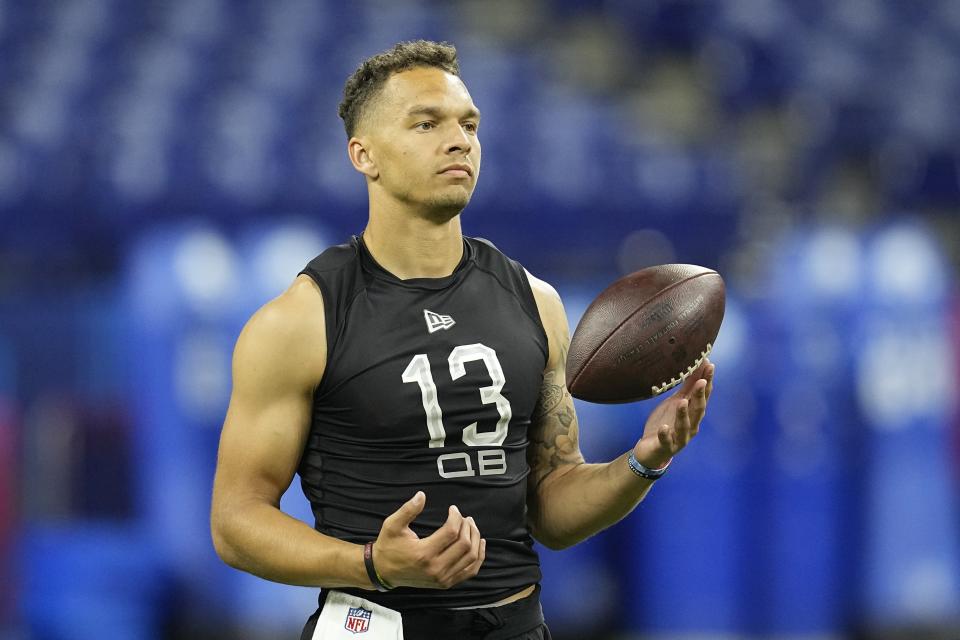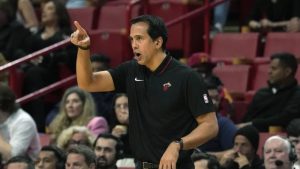NFL draft: Winners and losers from the 2022 NFL scouting combine

The 2022 NFL scouting combine, now in the books, didn’t pass without logistical challenges a year after the event was outright canceled because of COVID-19. The week ended with an air of nostalgia in Indianapolis, as combine veterans wondered if this was the last time the event will be held in the Circle City.
There was still plenty for NFL teams to chew on based on what happened on the Lucas Oil Stadium field.
We watched many of the drills and spoke with multiple NFL evaluators for their feedback on which players helped themselves and which ones now have work to do entering pro-day season.
NFL scouting combine winners
Liberty QB Malik Willis
Willis built off a good Senior Bowl week with a nice showing in the throwing drills Thursday night. The biggest oohs and aahs came when Willis was arcing his deep balls 40 and 50 yards downfield with ease.
How much stock should be put into that? It’s debatable. He also wasn’t pristine in his accuracy underneath, and he didn’t run the 40-yard dash.
Overall, Willis is the buzz guy at QB this year. If any team is considering a Trey Lance-like trade up, this is the player for whom they’d be doing it. Willis has flaws, but it’s hard not to get excited about the easy pop and velocity in his throws.
The behind-the-scenes reports have been good, too. Willis was praised for his natural leadership during drills and acquitted himself well during team interviews.
Cincinnati QB Desmond Ridder
We expected Ridder to test well, and he didn’t disappoint, with a 4.49-second 40, a 36-inch vertical and 10-foot-7 broad jump, all indicative off a top-tier athlete. His athletic template is considered elite for a quarterback, and the 6-3, 211-pound Ridder even holds up when you compare his numbers to wide receivers.
During his throwing session, Ridder displayed good rhythm and touch. In games, he doesn’t consistently display precision, but his mechanics, ball placement and even arm strength were all pretty strong on Thursday.
After a sluggish start to his Senior Bowl week, Ridder incrementally has improved his postseason performance. The first round might not be out of the question if teams are convinced that he can be a leader and clean up some of his likely fixable issues. He gives some Marcus Mariota vibes.
Michigan State RB Kenneth Walker III
Do we have our RB1? There might not be consensus at many positions in the 2022 draft, but Walker at least staked his claim for top honors at his position.
We thought a mid-4.4 40-yard dash would be a good time for Walker, and he bettered that with a scalding 4.38-second time — at 211 pounds, mind you. His jumping drill numbers were fine, and he measured shorter than expected at under 5-foot-10.
The biggest questions about Walker were addressed with firm responses. Can he catch?
That was a worry for a player with 19 college receptions, but his combine workout belied that; he looked very comfortable in receiving drills. Walker also displayed good foot fire and quickness on the field, suggesting he’s not just a straight-line burst player.
South Dakota State RB Pierre Strong
We’ve extolled the virtues of Strong for a minute now, and his Friday performance helped validate the praise. He did the most to help himself out of almost any RB at the event, displaying terrific speed (4.37 40), great explosiveness (36-inch vertical), and nice hands and route efficiency in receiving drills.
Even with a slightly smaller frame than expected, Strong profiles as a Tevin Coleman-ish back, now likely to be drafted somewhere later on Day 2.
Western Michigan WR Skyy Moore
After this weekend, Moore has moved into the Round 2 discussion — and perhaps the top 50 overall. There was even more buzz for him behind the scenes than expected, as Moore ran a nice 40 (4.41) and was as adept as almost any receiver adjusting to off-target passes. More than anything, Moore’s ball-tracking ability looked natural and unusually good.
Even with a small frame and some so-so testing numbers (namely a 7.13-second 3-cone drill), we feel comfortable calling him a winner this weekend. Some talent evaluators we spoke with like him better as a prospect than his former college teammate, D’Wayne Eskridge, a Seattle Seahawks second-rounder last year.
Memphis WR Calvin Austin III
Another player building momentum from a strong Senior Bowl week, Austin has carried on the strong recent Memphis tradition of producing fascinating offensive skill prospects. He might not quite be 5-foot-8 and 175 pounds — numbers that will fall below some teams’ size thresholds — but Austin is an explosive athlete whose testing numbers could push him into the Day 2 discussion.
A 4.32-second 40, 39-inch vertical leap and 11-foot-3 broad jump were among the best WR numbers in all three tests, and Austin showed natural hands catching the ball in drills. He’ll have limitations in the NFL but he could emerge as a big-play specialist.
2 lesser-known tight ends
Another player we’ve spilled some Twitter love for is Virginia TE Jelani Woods, who stands 6-foot-7 and weighs 259 pounds. He turned in eye-opening numbers in the 40 (4.61 seconds) and on the bench press (24 reps with 34-inch arms).
Maryland TE Chigoziem «Chig» Okonkwo was not a player we spent a lot of time dissecting. After his Indy performance, changing that is a high priority. The 238-pound Okonkwo turned in a 4.52 40-yard dash, which was faster than four wide receivers, including potential first-rounder Treylon Burks.
Both TEs turned heads at the East-West Shrine Game practices and did their best to keep the momentum going with good combine efforts. Each are developmental and perhaps scheme-specific prospects, and they’re very different styles of tight ends (however you define that position).
But Woods and Okonkwo each made compelling cases for themselves at the combine, catching the ball and moving well. Can they crack the top 100?
North Carolina State OT Ikem Ekwonu
We understand why Alabama’s Evan Neal chose not to work out; as the current favorite for the No. 1 overall pick, he might have had little to gain in doing so. But Ekwonu did his best to make a run at Neal for OL1 honors with a strong performance.
We’ve told Ekwonu’s fascinating story already, and it’s no shock that talent evaluators were impressed behind the scenes with Ekwonu’s intelligence, maturity and personality. His testing prowess was good (headlined by a 4.93-second 40), but his on-field performance was better.
Ekwonu showed excellent footwork, quickness and reaction skills in the drills, and he likely will receive residual benefit from the play of Tristan Wirfs and Rashawn Slater early in their careers. Like them when they came out, the 6-4 Ekwonu’s length has been questioned, but those fears feel nitpick-y after watching him work and dominate at tackle the past few seasons.
Georgia DT Jordan Davis
By now you likely have seen the video of Davis smoking his 40-yard dash with a smoldering 4.78-second time (and a 1.68-second 10-yard split). How can you not be impressed? It was nearly a full second faster than a player of comparable size, Idaho’s 346-poound Noah Elliss.
Relatively speaking, Davis’ broad-jump number (10-foot-3) boggles the mind even more. Per Stathead, the only other NFL prospect (at any position) 300 pounds or heavier to crack the 10-foot mark at the combine since 2000 was Tristan Wirfs. At 320 pounds, Wirfs jumped 10-foot-1. Davis, at a hulking 6-foot-6 and 341 pounds, bested that mark by 2 inches.
Davis becomes a fascinating debate. He’s almost certainly a first-round draft pick, but how much value do teams put in his perceived lack of stamina? Some of that is overblown. Davis might never be a true pass-rush threat, but his rare combination of mass and explosion could be lethal in the right system. He looked shockingly spry in drills and finished strong.
LSU LB Damone Clark
It’s been a good few weeks for Clark, who had a nice Senior Bowl followed by a productive combine. He showed up with a good combination of size (6-foot-2 1/2, 239 pounds) and testing (4.57 40, 36 1/2-inch vertical, 10-foot-7 broad jump). Clark also impressed in drills, looking stronger in the pass-coverage element than some might have expected, and was good in interviews, too, we’re told. He’s possibly in the top-50 range.
Georgia S Lewis Cine
Cine might have helped himself as much as any Bulldog at the combine — including Davis. With his good length (6-foot-2, 199 pounds, 32 1/4-inch arms), assertive and urgent tape, and excellent testing (4.37 40, 11-foot-1 broad jump), Cine might have entered the Round 1 discussion.
Cincinnati CB Ahmad ‘Sauce’ Gardner
Gardner answered questions about his long speed by running a 4.41 40 at 6-foot-3 and was excellent in on-field drills. With LSU’s Derek Stingley sidelined this past weekend, Gardner made a case for CB1 honors with an impressive all-around combine workout.
We thought he’d land in the first 15 or 20 picks overall coming into the event. Now the clock for him might start with the New York Giants, who pick fifth and seventh.
UTSA CB Tariq Woolen
After the 6-4, 205-pound Woolen registered one of the highest on-field speeds (22.45 mph) during Senior Bowl practices, he showed that putting on track shoes doesn’t slow him down, running a 4.26-second 40. That’s the kind of time that can change the calculus for where he’s drafted, as can his 42-inch vertical (tied for the best at this year’s combine at any position).
Woolen is still green, having flipped from receiver to corner two years ago. He made big strides this past season and could be something special in time. How high does a team draft a player with those numbers but limited experience? Our advice: Bet the under on his draft position. Woolen is likely going higher than expected.
Sam Houston State CB Zyon McCollum
Another stunning CB tester was McCollum, who put up some Dominique Rodgers-Cromartie-like numbers at the combine. At 6-2 and 199 pounds, McColllum ran a 4.33 40, vertical jumped 39 1/2 inches and broad jumped a positional-best 11 feet. Perhaps his best numbers were in the short shuttle (3.94 seconds) and three-cone drill (6.48) — the only corner to run those drills at the combine.
McCollum has some fascinating tape, too, with 13 INTs and six forced fumbles in his career, even if he’s still considered a developmental project in many respects. But if there’s a DB whom talent evaluators might put back under the microscope more after this weekend, it’s him.
NFL scouting combine losers
Ole Miss QB Matt Corral
The ankle injury he suffered in the Sugar Bowl kept Corral off the field in Indy. That’s now two events (along with the Senior Bowl) where the higher-end QB talents have added to their dossiers while Corral continues rehabbing. Corral said he felt «100 percent» healthy but didn’t throw or work out in Indianapolis.
«It does absolutely kill me,» Corral said. «I’m itching to get back out there. About two and a half weeks ago, I started running and throwing with no pain. I just thought it would be smart to sit out. If I wanted to put my best foot forward, just wait until my pro day.»
Now everything falls on that performance, scheduled on March 24, for Corral to make a statement, beyond anything his game tape. Did not working out at the combine end his first-round dreams? Absolutely not. But he’s been a bit of a forgotten man while other QBs have been able to put their best foot forward.
Miami QB-WR D’Eriq King
King scored points when he told teams he’d be willing to switch to receiver, as well as play special teams, in order to make it in the NFL. It appears that will have to be his path into the league, though his athleticism and skills give him a chance.
The 5-8 3/4, 196-pounder was inconsistent with his ball placement in passing drills and did not perform in the athletic testing drills to give an idea of what he might look like catching the ball, something he hasn’t done in a few years.
His extremely short arms (28 7/8 inches) won’t help his case, either. King’s character is a big plus, and his do-what-it-takes mentality will give him a shot somewhere. But his path to success will come with some challenges — at any position.
Texas A&M RB Isaiah Spiller
What happened here, well, we’re not sure. Spiller has some fun tape and solid production despite some unfavorable conditions in 2021. But his combine workout was downright disappointing.
First, he didn’t run the 40. Then he turned in average numbers in the vertical (30 inches) and broad jumps (9-foot-6) and was inconsistent in drills, dropping a few balls and running upright. One talent evaluator bemoaned Spiller’s physique, too, feeling it lacked definition.
Perhaps a good pro day 40 time can give him a boost. Still, Spiller risks falling behind on the RB pecking order otherwise.
Notre Dame RB Kyren Williams
We didn’t expect athletic fireworks from Williams this past weekend, but even so, his 4.65-second 40 time — at 5-foot-9, 194 pounds — did him no favors. That was the slowest 40 of all the running backs in Indy.
Williams’ value is going to be appreciated by savvy teams who can see what he offers on third downs as an able receiver and energetic pass protector. But it’s hard to make a case for an undersized lead back who doesn’t run fast and lacks explosion (32-inch vert, 9-foot-8 broad) being a bell cow at the next level.
Purdue WR David Bell
As one talent evaluator said this weekend, «I want to like him more than I do.» The 6-1, 212-pound Bell is what he is: a try-hard receiver with good determination and strong production but very blah athletic traits.
His workouts were not offensive but hardly convincing either. He turned in a 4.65 40 (with a 1.62 10-yard split), a 33-inch vertical, a 9-foot-10 broad jump and 7.14-second 3-cone drill, all middling or below for his size and position. But Bell’s 4.57 short shuttle is considered a bad time — far slower than several edge rushers and even worse than a few offensive and defensive tackles.
Bell caught the ball well in drills, was productive in college and displays more separation than you’d expect from a player with these limited testing numbers. But it’s harder to make a Day 2 case for him now than it was coming into the week.
Wisconsin TE Jake Ferguson
At a position that could provide surprising depth and talent in Rounds 3 and later, Ferguson risks getting lost in the shuffle. He’s a solid player when the whistle blows and the pads crack, but his athleticism is ordinary. Ferguson bench pressed only 15 reps and ran a slow 40 (4.81).
Cincinnati LB-EDGE Myjai Sanders
Somehow, Sanders measured in nearly an inch taller (6-foot-5 1/4) at the combine than he did at the Senior Bowl (6-4 3/8) but also 14 pounds lighter (from 242 to 228) in the span of a few weeks.
That’s odd. Was it because of speed training for the combine? If so, that makes Sanders’ 4.67 40 slightly disappointing. His numbers look good when comparing them to EDGE prospects, but at that weight he almost has to play off the ball in the NFL, likely as an odd-front outside linebacker.
We still like elements of Sanders’ game and believe he was badly miscast last season. His pro projection is tricky.
Texas A&M DL DeMarvin Leal
Six months ago, we wondered if Leal might be on the verge of landing in the top 10 or 15 picks. Now we wonder if he might slip out of the first two rounds.
At 6-4 and 283 pounds, he has the build of a 5-technique, which might already limit his appeal somewhat. Leal ran well enough, but his jumps (27.5-inch vert, 8-10 broad) were sub-par. Combine that with some inconsistent playmaking this past season, and you might be looking at a third-round pick now.
Leal’s on-field work was nothing special. Other DL prospects — including some bigger and longer — appeared to have more fluidity and burst alongside him.
Utah LB Devin Lloyd
He might still be LB1, but Lloyd was unexpectedly stiff in his on-field work and turned in a so-so 40 time of 4.66 seconds. His work in the jumps (35-inch vert, 10-foot-6 broad) and bench press number (25 reps) were both good. But we wonder if his mixed-bag performance warrants a top-15 or 20 selection. Teams that liked him coming into the week won’t suddenly bail on Lloyd, but we wonder how many new sets of eyes he opened.
Washington CB Kyler Gordon
Gordon was expected to be among the faster runners at his position, which is why is 4.52-second 40 was so disappointing. It’s not the kind of thing that should tank his stock, but the top-20 chatter has cooled.
Gordon’s 31-inch arm length is fine but hardly top-shelf either. Can he still land in Round 1? That might come down to team preference and scheme, but a strong pro-day bounceback might help that effort out. He’s not a worse player than when he showed up in Indy, but teams likely won’t feel compelled to reach for him quite as high otherwise.
LSU CB Derek Stingley Jr.
He is still sidelined by a concerning foot injury, opting out of combine workouts, and it’s not clear if he’ll run at his pro day. After missing big chunks of the past two seasons and facing some character questions, Stingley entered the combine with some unknowns. We don’t know a whole lot more than we did coming in, so his stock — would a team trust taking him in the top 10? — remains volatile.
Virginia Tech CB Jermaine Waller
After a good Shrine Game week, Waller took a step backwards at the combine in running the slowest 40 time among the cornerbacks (4.68) despite weighing only 180 pounds. That’s up five pounds from what he weighed in Las Vegas, but it’s certainly debatable if that added weight helped him at all.
Waller also opted out of the jumps, measured with sub-32-inch arms and was somewhat stiff changing directions during drills. He might still be a top-125 prospect, but Waller comes with some challenges.






